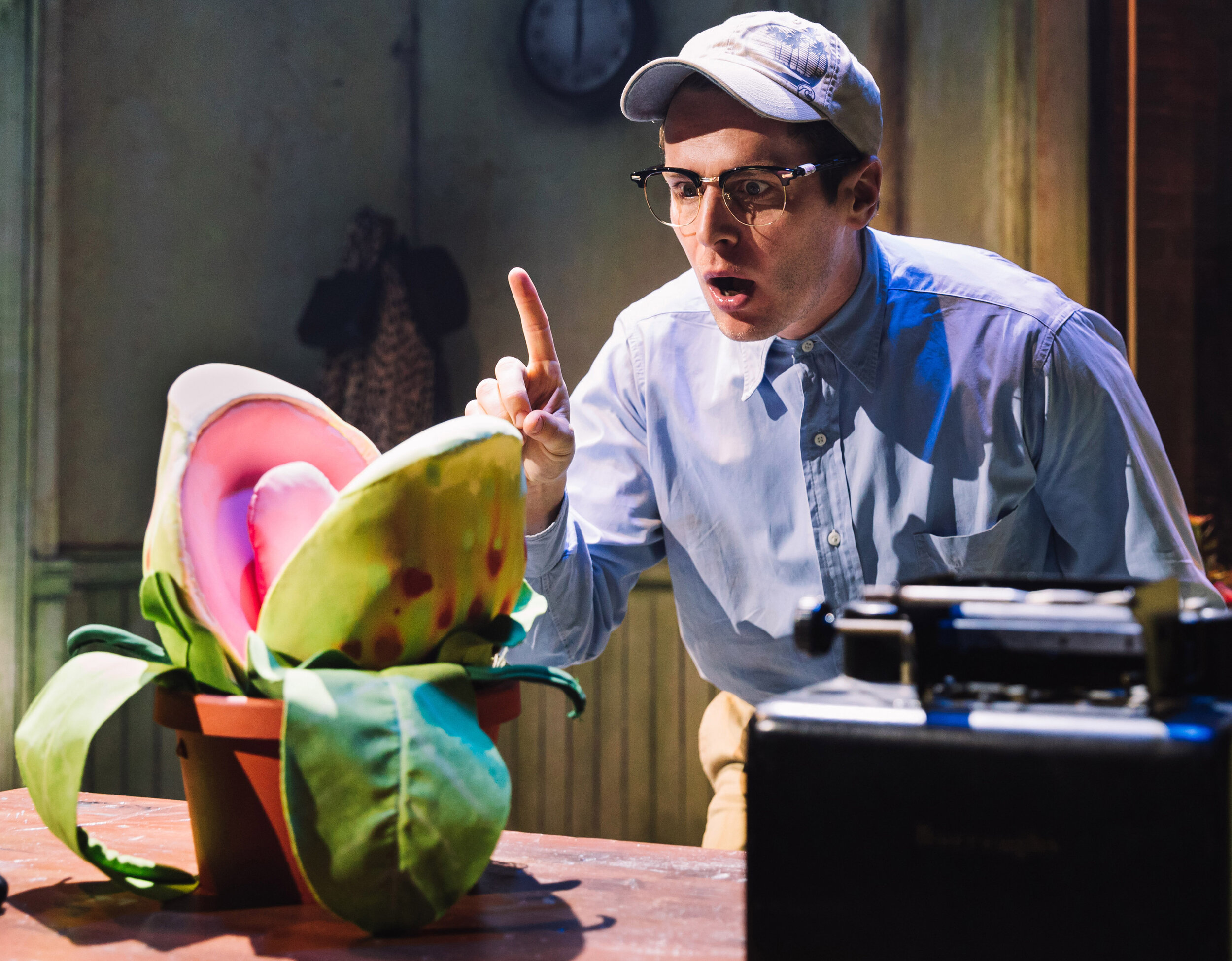In a new Off-Broadway revival of Little Shop of Horrors, Jonathan Groff as Seymour discovers that his mysterious plant likes only one food: blood.
Walter Kerr’s New York Times review of the original production of Little Shop of Horrors in 1982 started with a bloviating discourse on special effects’ ruination of good theater and its threat to the jobs of live actors. Then he added: “[T]he lyrics aren’t really witty enough to keep us eagerly attentive while the Equity membership is disappearing.” In our post–King Kong world, though, time has had its revenge. His clueless review is now an embarrassing read, while Howard Ashman and Alan Menken’s creation has an unassailable stature.
More than 35 years later, Little Shop of Horrors stands among a handful of great musicals with roots Off-Broadway. It still works as a sci-fi satire of American aspirations during the 1950s, as it did for the audiences who made their way to Third Avenue in the 1980s. The proof is Michael Mayer’s smart revival at the Westside Theater, a venue that is as crucial to the show as the Orpheum was to the original. Little Shop needs intimacy, and its incarnation on Broadway in 2003 at the Virginia (now the August Wilson) was disappointing.
From its “doo-wop”-style opener, the story unfolds on “Skid Row” (a choral trio of black women sings about downtown vs. uptown):
Groff as Seymour is threatened by the sadistic dentist Lawrence (Christian Borle).
Downtown
Where the cabs don’t stop.
Downtown
Where the food is slop.
Downtown
Where the hop-heads flop in the snow...
Down on Skid Row.
On Skid Row, Mushnik’s flower shop is on its last legs. Mushnik’s two employees are Audrey, a blond knockout with a squeaky voice and curves aplenty, and Seymour, a bespectacled schlub who is invariably clumsy but goodhearted, and carries a torch for Audrey. She, however, is dating “a semi-sadist” who blackens her eyes and breaks her bones.
The handsome Jonathan Groff as Seymour is less schlub than Lee Wilkof was in the original, so he has had to shift to nerd, and it works just as well. Although he starts a little vocally underpowered, he ratchets his voice up to where it needs to be. It’s Seymour who discovers a strange flytrap-style plant after a total eclipse of the sun and brings it into the shop. He is unable to nurse it to health until one night he chances on just the right food to make it open up: human blood. First by accident, then by design, he accedes to the plant’s demand “Feed me!” In return, he becomes a national expert on horticulture, and Mushnik (Tom Alan Robbins) is so determined to keep Seymour that he adopts his employee.
“Ashman’s death at only 40 from AIDS in 1991 is a reminder of the plague’s toll on great artistic talents. ”
Tammy Blanchard’s Audrey, meanwhile, is dating a brutal dentist—Lawrence, played with wild-eyed brio by Christian Borle (who undertakes some minor roles too). Blanchard captures the character’s ditzy innocence, as well as an unwavering affection to the dentist who abuses her physically, and her singing and enunciation are superb.
The psychological reasons that battered women stick by their men has been thoroughly explored since 1982, but the book by Ashman doesn’t need to delve into them; it may be ahead of its time, but if not, it’s smartly observed and intelligent. In “Somewhere That’s Green,” Audrey sings of her idealized life with a husband:
He rakes and trims the grass
He loves to mow and weed
I cook like Betty Crocker
And I look like Donna Reed
There’s plastic on the furniture
To keep it neat and clean
In the Pine-Sol scented air
Somewhere that’s green.
Groff with Tammy Blanchard as Audrey, the co-worker in the flower shop.
If Ashman’s topical references (“Donna Reed,” “Howdy Doody”) are unknown to post-millennials, it doesn’t matter. Cole Porter’s work holds up in spite of references to Margie Hart and Lady Mendl. Ashman’s death at only 40 from AIDS in 1991 is a reminder of the plague’s toll on great artistic talents.
There are only a few hiccups in this production. At times the chorus seems to stretch syllables to the point of incomprehensibility, and even a keen ear can’t make out every word; when they wear dental braces for a sight gag, it’s at the expense of clarity. Still, Menken’s melodies are a joy, and Nicholas Mahon’s Audrey II puppet, voiced by Kingsley Leggs, has the right balance of comedy and deep-voiced menace.
Mayer keeps the pacing taut, and Blanchard and Groff have real chemistry. Their second-act duet, “Suddenly Seymour,” is a knockout. Borle’s appearances in bit parts are unexpected and charming, as is the chorus of sassy women. If you haven’t seen, or revisited, this terrific show in a long time, here’s your chance.
Little Shop of Horrors plays at the Westside Theatre Upstairs through Jan. 19, 2020. Evening performances are at 7 p.m. Tuesday and Thursday, and at 8 p.m. Wednesday, Friday and Saturday; matinees are at 2 p.m. Wednesday and Saturday and at 3 p.m. Sunday. For more information, call the box office at (212) 239-6200 or visit telecharge.com.





